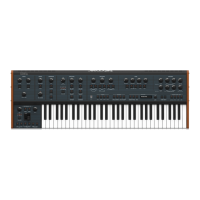6 UB-Xa User Manual
Manual Controls
The settings of these controls are universal and are not stored as part of any
programmed or preset patch, with the exception of patch volume (1).
(1) VOLUME – controls the overall level of the UB-Xa to your amplier or
mixing desk. Care should be taken when changing patches, as some stored
patches will be louder than others. It is recommended that the UB-Xa is
powered up with the volume at its minimum and before the amplier or
mixing desk that it is connected to.
(2) BALANCE – when using a split or double program the Balance control
adjusts the level between the two patches associated with the program.
When using a split program (one where the keyboard is split into lower
and upper, each with its own patch) turning the Balance control to
the left emphasizes the lower keyboard; to the right the upper. When
using a double program (one in which there are two patches playing
simultaneously) turning to the left emphasizes the patch associated with
the lower keyboard; right the upper. More on Split and Double programs
below.
(3) AUTO – the UB-Xa will run an auto calibration routine in the background
(depending on the settings in the Globals>Misc menu). Pressing the Auto
button shows the current calibration state. Holding the button keeps the
routine running.
(4) CHORD – holding a chord on the keyboard and pressing the Chord button
allows you to play that chord using any key on the keyboard, with the
chord being transposed to the selected key. Pressing Chord again switches
o the function. This function can also use used in conjunction with the
Hold button (see Arpeggiator). Note priority can be set in the Vel>Aft
menu.
(5) MASTER TUNE – allows you to adjust the overall tuning of the UB-Xa to
ensure that it is in tune with other instruments.
Control Section
(6) PORTAMENTO – this control aects the speed at which the pitch glides
between notes. Portamento is polyphonic, so each note will glide at a
dierent rate until its new pitch is reached. Portamento also works in
Unison mode (see below). When the control is set fully left (CCW) there
will be no portamento eect and notes will change instantly. When set
fully to the right (CW) the maximum time possible will be taken to glide
between pitches.
(7) UNISON – turns the UB-Xa into a monophonic synthesiser. In Unison
mode hold the Shift button and use the Unison button to select between
1 – 16 voices or 16 voices per key. In split mode Unison can be selected
independently for lower and upper keyboard; so, for example, you could
have the lower keyboard as normal to play chords, while setting the upper
keyboard to Unison for lead patches.
(8) OSC 2 DETUNE – this control allows you to set the oscillator 2 voices
to be slightly sharp or at relative to oscillator 1, giving a fatter sound,
particularly in Unison mode. Turning the control to the left (CCW) attens
oscillator 2 by around 50 cents, right (CW) sharpens it by the same amount.
An LED above the control indicates whether oscillator 2 is detuned. When
the LED is not lit then then oscillators are in tune.
Arpeggiator (Arp)
(9) RATE – controls the rate at which the arpeggiator and internal sequencer
(see below) run when Internal Sync is selected using the Settings Menu
(see below). Rate can be adjusted between 40 and 240 bpm.
(10) SETTINGS – allows access to the settings menu. There are ve options,
which can be scrolled through with the rotary encoder (62):
1. Arp Mode
2. Arp Time
3. Arp Gate Time
4. Sync
5. Octave
Pressing the rotary encoder allows access to the sub-menu options:
Arp Mode
a - Up – notes held play upwards from lowest to highest (default).
b - Down – notes held play downwards from highest to lowest.
c - Inclusive – notes held play upwards from lowest then downwards
from highest with repeats (1 / 2 / 3 / 4 / 4 / 3 / 2 / 1 / 1 etc).
d - Exclusive – notes held play upwards from lowest then downwards
from highest without repeats (1 / 2 / 3 / 4 / 3 / 2 / 1 etc).
e - Random – notes held play randomly.
f - Order – notes play back in the order that they are held (so holding
C1 and C4 then adding C2 would give C1, C4, C2).
g - Up x 2 – notes play upwards from lowest to highest, with each
being played twice (1 / 1 / 2 / 2 / 3 / 3 / 4 / 4).
h -Down x 2 - notes play downwards from highest to lowest, with
each being played twice (4 / 4 / 3 / 3 / 2 / 2 / 1 / 1).
i – Up x 3 - notes play upwards from lowest to highest, with each
being played three times (1 / 1 / 1 / 2 / 2 / 2 / 3 / 3 / 3 / 4 / 4 / 4).
j – Down x 3 - notes play downwards from highest to lowest, with
each being played twice (4 / 4 / 4 / 3 / 3 / 3 / 2 / 2 / 2 / 1 / 1 /1).
k – Up x2/x3 – notes play upwards from lowest to highest, with each
being played twice on even time settings and three times on triplet
settings.
l – Down x2/x3 – notes play downwards from highest to lowest,
with each being played twice on even time settings and three times
on triplet settings.

